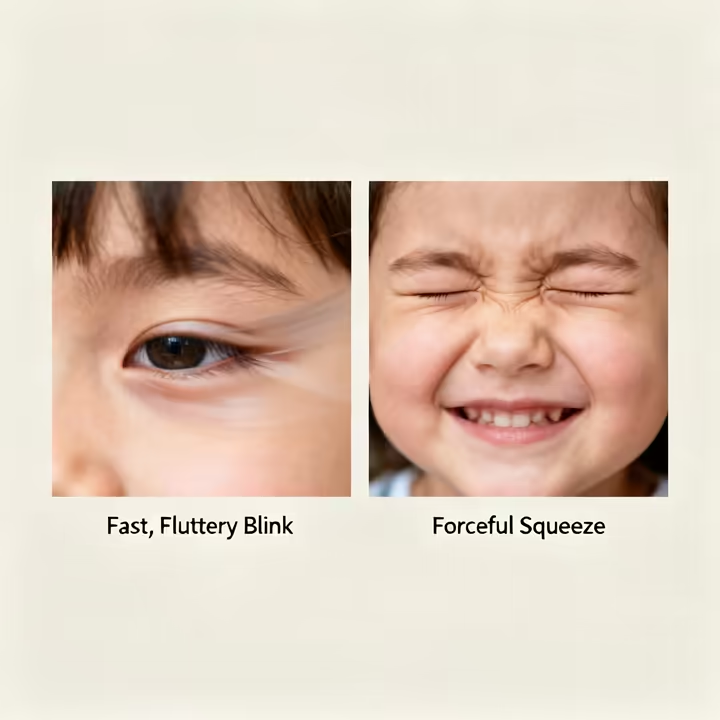Understanding Your Child’s World: A Compassionate Guide to Excessive Blinking
You’ve noticed your kid is blinking... a lot. A fast, fluttery blink, or maybe a hard, forceful squeeze. Before you spiral down a late-night internet rabbit hole, take a breath. This is super common, and it’s rarely a sign of anything serious. 1 Often, it’s just your child’s way of telling you something.

What Does 'Excessive Blinking' Even Mean?
Blinking is normal, of course. Newborns only blink about twice a minute. By the teen years, it’s up to 14-17 times a minute, and it stays that way for adults. 3 “Excessive blinking” just means... well, blinking more than that. 5 You’ll know it when you see it.
But it’s not just about how many blinks. It’s also about how they blink. Look closely, because the style of the blink can tell you a lot.
Fast, Fluttery Blinks
This is just what it sounds like, a quick, light flutter. The blinks aren't strong, just really frequent. Think of it as the body’s way of dealing with an itchy eye or trying to get rid of a speck of dust. 6
Forceful Squeezing
This is a much bigger, more deliberate movement. Your child squeezes their eyes shut, hard, sometimes with other facial grimaces. 2 A light flutter might be a speck of dust, but a hard squeeze is usually a reaction to something more intense, like stress or feeling overwhelmed.

Long Eye-Closing
Sometimes a kid will close their eyes and just... keep them closed for a second or two. 8 It’s a deliberate pause from seeing. This is a super clear signal, especially in toddlers, that they are trying to block out something they don't like.
First Things First: Check the Obvious Stuff
Before you jump to more complicated explanations, start with the simple physical causes. Most of the time, the answer is right there and easy to fix. 1 Always check these things out with a doctor first.
Eye Issues and Vision Problems
Often, the problem is... the eye. Problems with the cornea, the front surface of the eye, are a top cause in kids. 1 It could be a stray eyelash, a bit of dust, or allergies to pollen or the family cat making their eyes itchy. 10, 5 Dry eyes (hello, screen time!) or infections like pink eye can also cause a kid to blink up a storm. 2
Sometimes, blinking is a kid’s attempt to see better. If they are nearsighted or farsighted, they might blink to try and clear up blurry vision. 1 It can also be a sign of misaligned eyes (strabismus), where blinking is an attempt to get things to line up again. 3

Habit Tics
If an eye doctor gives the all-clear, the blinking might be a simple motor tic. Tics are quick, repetitive movements that are mostly involuntary. 14 Eye blinking is one of the most common childhood tics. 16 They often show up around age 5 (more in boys) and can get worse with stress, tiredness, or even excitement. 5
Lots of kids say they get an uncomfortable urge right before the tic, a feeling that only goes away when they do it. 14 They can sometimes hold it back for a bit, but it’s hard work. This isn't a "bad habit" they can just stop. The good news? Most of these tics are harmless and go away on their own within a year. 1
Stress and Tiredness
Never underestimate the power of stress and tiredness. When a kid is stressed about school or anxious, their body gets tense and they might blink more. 5, 21 Just being overtired can do it too, making it harder to control small muscle movements. 16
And be careful not to create a feedback loop. A kid starts blinking because they need glasses. You say, "Stop blinking so much!" Now the kid is anxious about the blinking... which makes them blink even more. 14 This is why a low-key approach is best.
Blinking, Autism, and a Different Kind of Brain
Okay, so you've ruled out eye problems and simple tics. Now we can look at how blinking connects to neurodiversity, especially autism. For many neurodivergent kids, blinking isn't random, it's a tool. It's how they handle an overwhelming world, manage anxiety, and keep their nervous system in balance.

Blinking to Self-Regulate (Stimming)
First up is “stimming” (self-stimulatory behavior). Stimming is any repetitive movement that helps a person regulate their senses and emotions, and it’s a totally normal part of being autistic. 22, 24 It’s not a bad habit, it's a coping tool.
Many autistic people process sensory information differently, sometimes being over-sensitive or under-sensitive to sights, sounds, and textures. 8 Blinking can be a form of visual stimming . 27 For a kid overwhelmed by bright lights or busy patterns, each blink is like a mini-break, a tiny moment of darkness to reset a frazzled nervous system. 13
The Toddler Eye-Squeeze
If fast blinking is turning down the volume, forcefully squeezing the eyes shut is yanking the plug out of the wall. It’s a powerful sensory block. 27 A toddler doing this is sending a crystal-clear message: "I am completely overwhelmed by what I’m seeing and I need it to STOP." 13 It’s not a tantrum, it’s a survival strategy.
Tics Can Happen Too
To make things extra fun, autism and tic disorders overlap a lot. Somewhere around 22% to 34% of autistic people also have tics. 31 So for some kids, the blinking might be a stim, a tic, or both.
What’s the difference? A stim is usually a tool to manage the senses. A tic is driven by an irresistible urge that builds up and needs to be released. 33 From the outside, they can look exactly the same, which is why it's good to talk to a pro who gets both.
A Way to Communicate
Blinking can also be a sign of anxiety. For many autistic kids, the steady, rhythmic motion is calming when they feel overwhelmed inside. 8
For a child who has trouble with words, blinking can be their way of talking. 36 They can’t say, “This grocery store is a nightmare of fluorescent lights and beeping sounds,” but they can show you by blinking really fast. It’s a “check engine” light. If you spot it, you can help them get out of there before things escalate.
So... What Should I Do?
So you've got some ideas about why your kid is blinking. The goal isn’t to “fix” the blinking. It’s to figure out what the blinking is trying to tell you.
Play Detective, Not Doctor
Your best tool is just watching. For a few days, be a detective. When does the blinking happen most? During screen time? In a noisy supermarket? When they're tired or nervous about something? 1, 13
The number one rule: Don’t make a big deal about it. Telling a kid to "stop blinking" is a terrible idea. If it's a tic, they can't control it, and if it's sensory-related, your nagging will just add to their stress and probably make it worse. 15 Just chill and observe.
When to Call in the Pros
Your detective notes will be super helpful when you talk to a professional. Always start with a pediatrician or an eye doctor. They need to rule out the simple stuff first, like allergies, dry eye, or needing glasses. 1
If the eye exam is clear but the blinking continues, your doctor might suggest a specialist. A developmental pediatrician can look for conditions like autism. A pediatric neurologist is the expert on tic disorders. And a sensory-focused occupational therapist can be a game-changer for figuring out and managing sensory issues. 16
Tips for Home
While you wait for appointments, you can do a lot at home. The golden rule is: change the environment, not the kid. If you think sensory overload is the culprit, try using dimmer lights, reducing clutter, or bringing noise-canceling headphones on errands. 27
Set up a "calm-down corner" somewhere in the house. It doesn't have to be fancy, just a quiet spot with a beanbag chair, a soft blanket, and a few fidget toys. 36 It's a safe place for them to go when they need to reset.

In the moment, respond to the feeling , not the blink. If the blinking starts at a loud party, you could whisper, "Wow, it's really loud in here. Let's go hang out in the quiet hallway for a minute." This shows them you get it and you’re on their team.
The Bottom Line
Look, that fluttery eye or forceful squeeze can be worrying. But the blinking itself isn't the problem, it's a clue. 25 It's your kid's way of telling you something is up when they don't have the words. By figuring out what it means, you're not just solving a blinking issue, you're learning to understand your kid's world a little better.
Works cited
- Excessive Blinking in Children - American Academy of Ophthalmology, https://www.aao.org/eye-health/diseases/excessive-blinking-children
- How to stop excessive blinking in children | Top Doctors, https://www.topdoctors.co.uk/medical-articles/what-should-i-do-if-my-child-is-blinking-all-the-time/
- Excessive Blinking in Children - Texas Children's Hospital, https://www.texaschildrens.org/content/conditions/excessive-blinking-children
- Excessive Blinking in Children - Eyes 4 Kids, https://eyes4kids.com/blog/excessive-blinking-in-children/
- Excessive Blinking in Children: Causes, Symptoms, and Solutions, https://kideyedoc.com/excessive-blinking-children/
- Excessive Blinking in Children: Could It Be a Vision Problem?, https://prairievision.com/excessive-blinking-in-children-could-it-be-a-vision-problem/
- Excessive Blinking In Children With Autism: What It Means - Kids Club ABA, https://kidsclubaba.com/excessive-blinking-in-children-with-autism-what-it-means/
- Excessive Blinking In Kids With Autism: Causes & Symptoms, https://www.goldenstepsaba.com/resources/excessive-blinking-in-kids-with-autism
- Excessive Blinking in Children - American Academy of Ophthalmology, https://www.aao.org/salud-ocular/consejos/excessive-blinking-in-children
- Has Your Child Suddenly Started Blinking A Lot? - Monarch Bay Optometry, https://monarchbayoptometry.com/has-your-child-suddenly-started-blinking-a-lot/
- Why Do I Blink So Much? Excessive Blinking Causes & Treatments - All About Vision, https://www.allaboutvision.com/conditions/symptoms/excessive-blinking-causes-treatments/
- Excessive Blinking in Children | OasisEye Specialists, https://oasiseye.my/excessive-blinking-in-children/
- Understanding the Role of Excessive Blinking in Autism Spectrum Disorder, https://www.stepaheadaba.com/blog/excessive-blinking-in-children-with-autism
- Tics - NHS, https://www.nhs.uk/conditions/tics/
- Tics and Tic Disorders: What They Are, Causes & Types - Cleveland Clinic, https://my.clevelandclinic.org/health/diseases/tics-and-tic-disorders
- Why Has My Child Suddenly Developed a Tic? - Stony Brook Medicine Health News, https://health.stonybrookmedicine.edu/why-has-my-child-suddenly-developed-a-tic/
- Tic Disorders - Children's Hospital of Orange County, https://choc.org/conditions/psychology/tic-disorders/
- Tourette Syndrome in Children | Nemours KidsHealth, https://kidshealth.org/en/parents/tourette.html
- Children who tic - Naitre et grandir, https://naitreetgrandir.com/en/step/5-8-years/behaviour/children-who-tic/
- Kids Health Info : Tics - The Royal Children's Hospital, https://www.rch.org.au/kidsinfo/fact_sheets/Tics/
- Why Is My Toddler Blinking a Lot - Cleveland Clinic Health Essentials, https://health.clevelandclinic.org/excessive-blinking-in-children
- Stimming: children & teens with autism | Raising Children Network, https://raisingchildren.net.au/autism/behaviour/common-concerns/stimming-asd
- What is Stimming In Autism? – Lighthouse Autism Center, https://lighthouseautismcenter.com/blog/what-is-stimming-and-why-does-my-child-with-autism-stim/
- What is Visual Stimming? | Above and Beyond Therapy, https://www.abtaba.com/blog/what-is-visual-stimming
- 'People should be allowed to do what they like': Autistic adults' views ..., https://pmc.ncbi.nlm.nih.gov/articles/PMC6728747/
- Sensory Integration Disorders in Autism - Autism Research Institute, https://autism.org/sensory-integration/
- Visual Stimming: What can we do about it? - Healis Autism Centre, https://www.healisautism.com/post/visual-stimming-what-can-we-do-about-it
- What is Visual Stimming? Exploring its Role in Autism - The Treetop ABA, https://www.thetreetop.com/aba-therapy/what-is-visual-stimming
- What is Visual Stimming in Autism? | Level Ahead ABA, https://www.levelaheadaba.com/blog/visual-stimming-in-autism
- Why Does Excessive Blinking Occur in Autism? | Inclusive ABA, https://www.inclusiveaba.com/blog/excessive-blinking-in-autism
- Clinical characteristics of comorbid tic disorders in autism spectrum disorder: exploratory analysis - PMC, https://pmc.ncbi.nlm.nih.gov/articles/PMC10262579/
- Unraveling the Complex Relationship Between Tourettes and ..., https://www.stepaheadaba.com/blog/tourettes-and-autism
- Differences and similarities of ASD and Tourette Syndrome, https://www.tourettes-action.org.uk/storage/downloads/1610981978_Tourette's-&-Autism-article.pdf
- Excessive Blinking In Kids With Autism - The Treetop ABA, https://www.thetreetop.com/aba-therapy/excessive-blinking-in-kids-with-autism
- Excessive Blinking in Children with Autism: Causes and Treatments - Apex ABA Therapy, https://www.apexaba.com/blog/excessive-blinking-in-children-with-autism
- Excessive Blinking In Children With Autism - Magnet ABA, https://www.magnetaba.com/blog/excessive-blinking-in-children-with-autism
- Excessive Blinking in Autism | Level Ahead ABA, https://www.levelaheadaba.com/excessive-blinking-in-autism
- Addressing Excessive Blinking in Children with Autism | Brighter Strides ABA, https://www.brighterstridesaba.com/blog/excessive-blinking-in-children-with-autism/